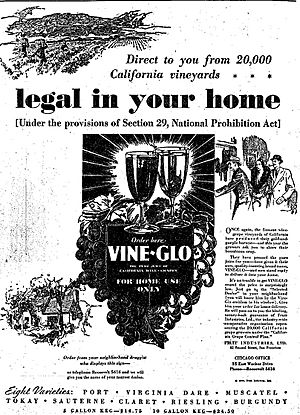Vine-Glo

Advertisement for Vine-Glo in the Chicago Tribune
|
|
| Type | Grape concentrate |
|---|---|
| Inventor | Joseph Gallo |
| Inception | 1929 |
| Manufacturer | Fruit Industries |
| Available | Not available |
| Last production year | 1931 |
| Website | Lua error in Module:WikidataIB at line 168: attempt to index field 'wikibase' (a nil value). |
Vine-Glo was a special brick of grape concentrate sold in the United States between 1929 and 1931. It was made by a company called Fruit Industries Ltd. This company was actually a part of the California Vineyardist Association (CVA). Vine-Glo was sold during a time known as Prohibition. This was when making or selling alcohol was against the law.
Vine-Glo was advertised as a product to make grape juice. However, it came with a very clear warning. This warning actually told people how to turn the grape juice into wine. In 1931, Fruit Industries stopped making Vine-Glo. This happened after a court decided that making wine from this concentrate was against the law. The law was called the Volstead Act.
How Vine-Glo Started
During Prohibition, the Volstead Act made alcohol illegal. But there were some special rules, or "loopholes," in the law. One rule, Section 29, said that non-alcoholic grape products could still be sold. People could also make fruit juices at home from these products.
The CVA, a group of grape growers, created Fruit Industries. They even got a big loan of $1,300,000 from the Federal Farm Board. A man named Joseph Gallo invented Vine-Glo. He was the father of famous winemakers Ernest and Julio Gallo. Vine-Glo was a legal grape concentrate brick. It was sold through Fruit Industries.
The packaging for Vine-Glo had a very interesting warning. It said: "After dissolving the brick in a gallon of water, do not place the liquid in a jug away in the cupboard for twenty days, because then it would turn into wine." Fruit Industries also told people that the product was "legal in your own home." They even promoted the Farm Board.
Selling Vine-Glo
When Vine-Glo first went on sale, it was very popular. In its first year, one million gallons of Vine-Glo were sold. The company even created eight different wine-flavored varieties. People bought the product all across the United States.
In 1930, Fruit Industries wanted to sell Vine-Glo in Chicago. They made a public statement. They claimed that a famous gangster had tried to stop them. But they said they would not be scared and would continue selling. Some people think this was just a clever way to get more attention for the product. Vine-Glo eventually went on sale in New York State in 1931.
Why Vine-Glo Stopped
When Vine-Glo first came out, people who supported Prohibition were not happy. These people were sometimes called "drys." However, a government lawyer named Mabel Walker Willebrandt said that Vine-Glo was legal. The government agency in charge of Prohibition also told its agents not to stop shipments of Vine-Glo.
By 1931, Fruit Industries put out advertisements. They insisted that Vine-Glo followed all laws. This was because people who supported Prohibition kept criticizing them. Later, Mabel Walker Willebrandt left the government. She then became a lawyer for Fruit Industries. This caused problems because it looked like a conflict of interest. The government then started to view Vine-Glo more strictly.
In October 1931, Fruit Industries received another big loan. But in the same month, a judge ruled that grape concentrate could not be used to make fruit juice legally. Fruit Industries stopped making Vine-Glo a month later. The head of the Prohibition agency agreed with the court's decision. He said that grape concentrate would no longer be allowed under Section 29 of the law.
See also
 In Spanish: Vine-Glo para niños
In Spanish: Vine-Glo para niños

